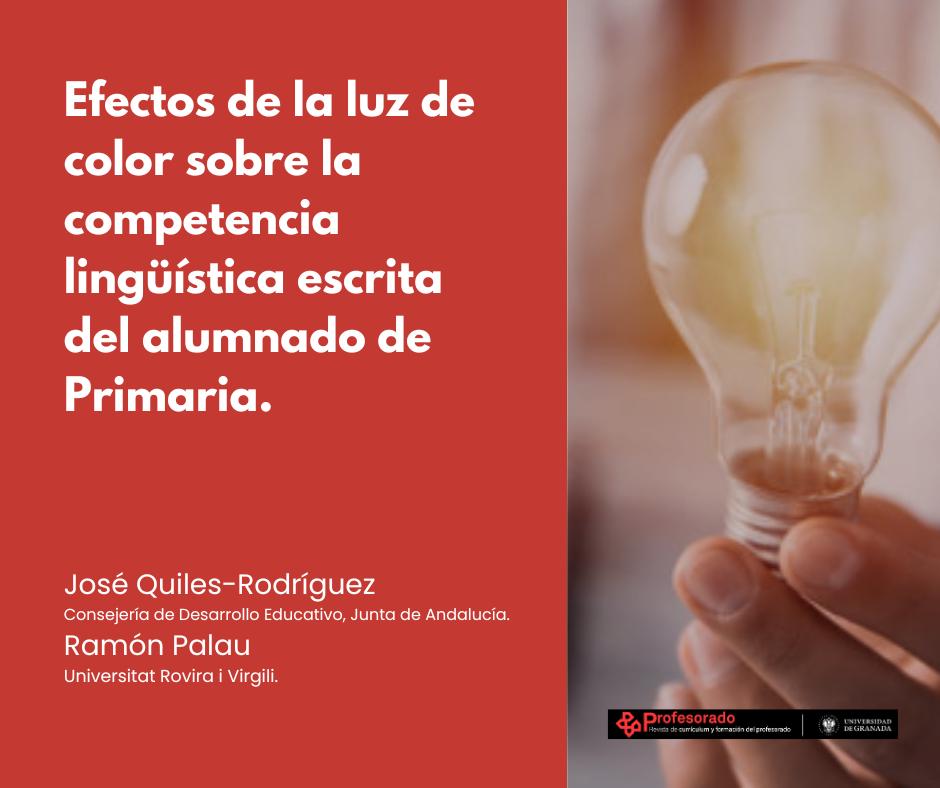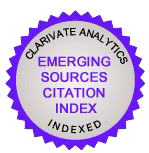Efectos de la luz de color sobre la competencia lingüística escrita del alumnado de Primaria
DOI:
https://doi.org/10.30827/profesorado.v28i2.29643Palavras-chave:
Color, entorno de aula, entorno educacional, iluminación, lenguaje escrito, lingüísticaResumo
Los colores de los entornos educativos afectan a los procesos cognitivos y de aprendizaje del alumnado. Tradicionalmente esto se ha tenido en cuenta y se ha podido estudiar con el color de los elementos del aula. Dichos estudios no acaban de alcanzar la sistematicidad y rigor necesarios como para extraer unas conclusiones prácticas. Actualmente la tecnología de luz emitida por diodos (LED) permite generar una fuente de “luz de color” integrante del entorno de aula, cuya peculiaridad dinámica permite que se pueda ir adaptando a las necesidades del proceso educativo. Como muestran trabajos previos, la exposición a diferentes escenarios de “luz de color” puede influir en el aprendizaje. En el estudio actual se analiza la influencia de dicha “luz de color” sobre el alumnado de educación primaria, más específicamente sobre su competencia lingüística escrita. Para ello se ha utilizado una metodología cuasi-experimental basada en el diseño de materiales equivalente que ha tenido lugar en un colegio rural de educación primaria, donde se han diseñado cuatro escenarios de “luz de color”, ejerciendo el primero de ellos como pretest. Se han tomado valores repetidos de expresión y comprensión escrita, observando como estas se pueden ver determinadas por el cambio de los diferentes escenarios de “luz de color”. Los resultados de la investigación son dispares, encontrando valores más conclusivos para la expresión escrita mientras que no tanto para la comprensión. En cualquier caso, el dinamismo de la “luz de color” se erige como una tecnología interesante para su aplicación en el aula.
Downloads
Referências
Ackah-Jnr, F. R., & Danso, J. B. (2019). Examining the physical environment of Ghanaian inclusive schools: How accessible, suitable and appropriate is such environment for inclusive education? International Journal of Inclusive Education, 23(2), 188–208. doi:10.1080/13603116.2018.1427808
Agencia Andaluza de Evaluación Educativa (2017). Evaluación final de educación primaria. Competencia lingüística. Junta de Andalucía.
Agencia Andaluza de Evaluación Educativa (2018). Evaluación final de educación primaria. Competencia lingüística. Junta de Andalucía.
Agencia Andaluza de Evaluación Educativa (2019). Evaluación final de educación primaria. Competencia lingüística. Junta de Andalucía.
Barrett, P., Davies, F., Zhang, Y., & Barrett, L. (2015). The impact of classroom design on pupils’ learning: Final results ofaholistic, multi-level analysis. Building and Environment, 89, 118-133. https://doi.org/10.1016/j.buildenv.2015.02.013
Barrett, P., Davies, F., Zhang, Y., & Barrett, L. (2017). The Holistic Impact of Classroom Spaces on Learning in Specific Subjects. Environment and Behavior, 49(4), 425-451. https://doi.org/10.1177/0013916516648735
Campbell, D.T. & Stanley, J.C. (1966). Experimental and quasi-experimental designs for research. Rand McNally & Company Chicago
Chacón-Moscoso, S. & Sanduvete-Chaves, S. (2018). Métodos, diseños y técnicas de investigación psicológica. Universidad de Sevilla.
Cheryan, S., Ziegler, S. A., Plaut, V. C., & Meltzoff, A. N. (2014). Designing Classrooms to Maximize Student Achievement. Policy Insights from the Behavioral and Brain Sciences, 1(1), 4–12. doi:10.1177/2372732214548677
Gilavand, A. (2016). Investigating the Impact of Environmental Factors on Learning and Academic Achievement of Elementary Students: Review. International Journal of Medical Research & Health Sciences, 5, 360-369.
Godwin, K., Leroux, A., Scupelli, P. & Fisher, A. (2022), Classroom Design and Children's Attention Allocation: Beyond the Laboratory and into the Classroom. Mind, Brain, and Education 16, 239-251. https://doi.org/10.1111/mbe.12319
Gross, R. (2015). Psychology: The science of mind and behaviour (7th ed.). Hodder Education.
Hviid, C., Pedersen C. & Dabelsteen K. (2020). A field study of the individual and combined effect of ventilation rate and lighting conditions on pupils’ performance. Building and Environment (Vol. 171) https://doi.org/10.1016/j.buildenv.2019.106608
Lee, H., Park, J. & Lee, J. (2021). Comparison between psychological responses to ‘object colour produced by paint colour’ and ‘object colour produced by light source.’ Indoor and Built Environment, 30(4), 502-519. http://doi.org/10.1177/1420326X19897109
Ley Orgánica 3/2018, de 5 de diciembre, de Protección de Datos Personales y garantía de los derechos digitales. BOE núm. 294. https://www.boe.es/eli/es/lo/2018/12/05/3
Ley Orgánica 3/2020, de 29 de diciembre, por la que se modifica la Ley Orgánica 2/2006, de 3 de mayo, de Educación. BOE núm. 340. https://www.boe.es/eli/es/lo/2020/12/29/3
Llinares, C., Castilla, N. & Higuera-Trujillo, J.L. (2021). Do attention and memory tasks require the same lighting? A study in university classrooms. Sustainability, 13, 8374. https://doi.org/10.3390/ su13158374
López-Fuentes, R., & Salmerón-Vilchez, P. (2011). Proceso de Investigación Educativa I : Investigación Experimental. En López Fuentes, R. (Coord). Innovación Docente e Investigación Educativa. Máster Universitario de Educación Secundaria Obligatoria y Bachillerato, Formación Profesional y Enseñanza de Idiomas (pp. 24–40). Universidad de Granada. https://www.ugr.es/~emiliobl/Emilio_Berrocal_de_Luna/Master_files/UNIDAD 1 El Proceso de Investigación Empírico Experimental.pdf
Manca, S., Cerina, V., Tobia, V., Sacchi, S., & Fornara, F. (2020). The effect of school design on users’ responses: A systematic review (2008-2017). Sustainability,12(8), 3453-3490. https://doi.org/10.3390/SU12083453
Mogas-Recalde, J., & Palau, R. (2021). Classroom lighting and its effect on student learning and performance: Towards smarter conditions. Smart Innovation, Systems and Technologies (Vol. 197). Springer. https://doi.org/10.1007/978-981-15-7383-5_1
Paredes-Daza, J. D., & Sanabria-Becerra, W. M. (2015). Ambientes de aprendizaje o ambientes educativos. “Una reflexión ineludible.” Revista de Investigaciones UCM, 15(1), 144-158. https://doi.org/10.22383/ri.v15i1.39
Poldma, T. (2009). Learning the dynamic processes of color and light in interior design. Journal of Interior Design, 34(2), 19-33. https://doi.org/10.1111/j.1939-1668.2008.01017.x
Quiles-Rodríguez, J., & Palau, R. (2023). Effects of Classroom Colour on Learning Processes for a Future Smart Classroom: A Systematic Review. In Antolí, J. (Eds.), Challenges of the Educational System in Contemporary Society (pp. 222-241). IGI Global. https://doi.org/ 10.4018/978-1-6684-8156-1
Quiles-Rodríguez, J., & Palau, R. (in press). Effects of colored lighting on learning processes: towards a smart classroom. Journal of technology and science education.
Reglamento (UE) 2016/679 del Parlamento Europeo y del Consejo, de 27 de abril de 2016, relativo a la protección de las personas físicas en lo que respecta al tratamiento de datos personales y a la libre circulación de estos datos y por el que se deroga la Directiva 95/46/CE (Reglamento general de protección de datos). DOUE núm. 119. https://www.boe.es/doue/2016/119/L00001-00088.pdf
Román-García, M., & Prendes, M.P. (2018). El informe del TFM. En Prendes, M.P. y González-Calatayud, V. (Coords.). Trabajo Fin de Máster en Tecnología Educativa. Orientaciones para la elaboración y criterios de calidad (pp. 59-67). Universidad de Murcia.
Sántha, K. (2019). Teacher trainees’ beliefs concerning efficient teaching and learning-Pedagogical spaces in focus. The New Educational Review, 55(1), 17–29. doi:10.15804/tner.2019.55.1.01
Suh, J. K., Park, E. K., & Iwamoto, D. (2020). Color-filtered lighting: Visual and emotional impact in learning environments. International Journal of Architectonic, Spatial, and Environmental Design, 14(1), 41-55. https://doi.org/10.18848/2325-1662/CGP/V14I01/41-55
Vidal-Rojas, R. A., & Vera-Avendaño, C. (2020). Influencia del color del aula en los resultados de aprendizaje en 3° año básico: estudio comparativo en un colegio particular subvencionado en Santiago de Chile. Revista Educación, 44(2), 91–113. https://doi.org/10.15517/revedu.v44i2.37283
Von Castell, C., Stelzmann, D., Oberfeld, D., Welsch, R. & Hecht, H. (2017). Cognitive performance and emotion are indifferent to ambient color. Color Research & Application. 43. https://doi.org/10.1002/col.22168

Downloads
Publicado
Versões
- 2024-12-18 (2)
- 2024-07-15 (1)


















